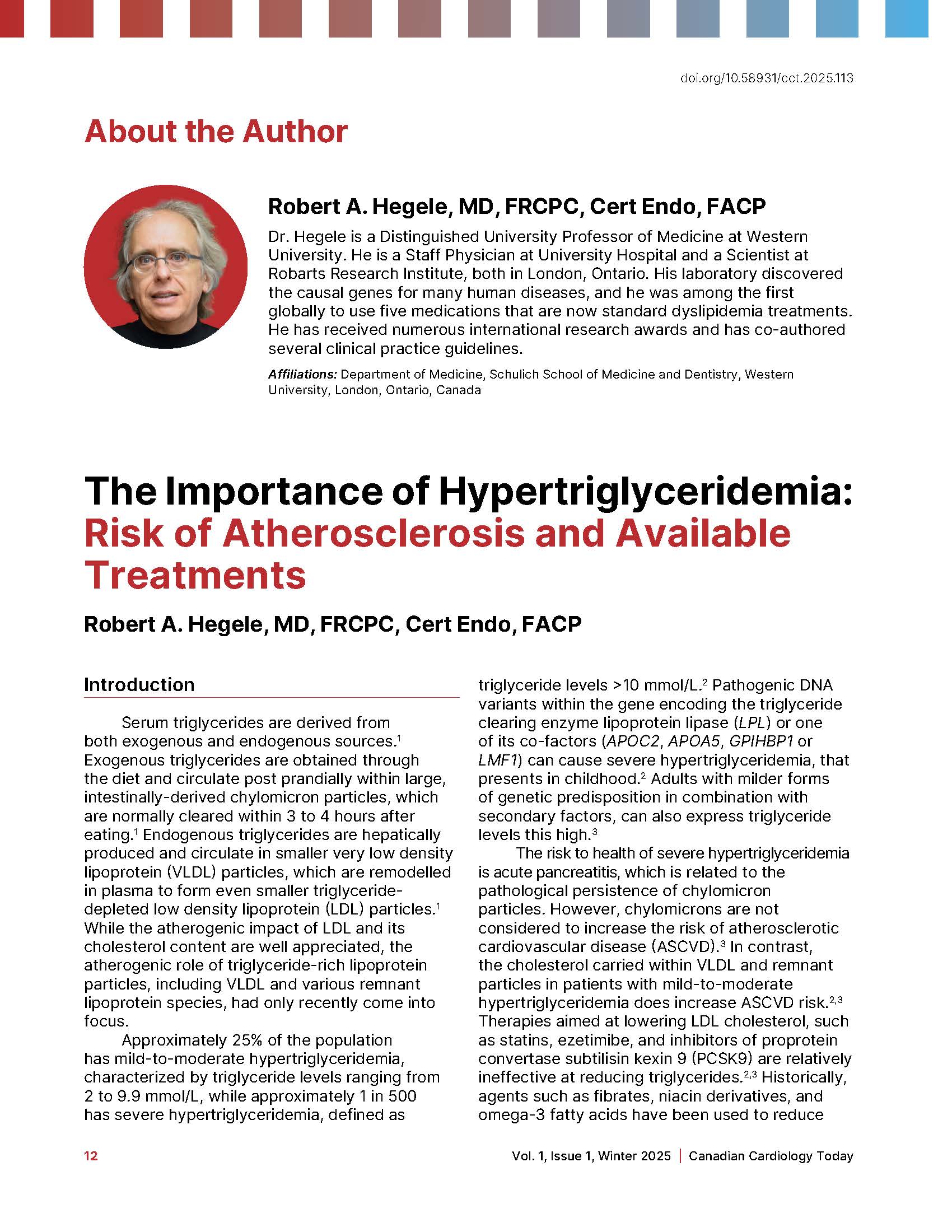The Importance of Hypertriglyceridemia: Risk of Atherosclerosis and Available Treatments
DOI:
https://doi.org/10.58931/cct.2025.113Abstract
Serum triglycerides are derived from both exogenous and endogenous sources. Exogenous triglycerides are obtained through the diet and circulate post prandially within large, intestinally-derived chylomicron particles, which are normally cleared within 3 to 4 hours after eating. Endogenous triglycerides are hepatically produced and circulate in smaller very low density lipoprotein (VLDL) particles, which are remodelled in plasma to form even smaller triglyceride-depleted low density lipoprotein (LDL) particles. While the atherogenic impact of LDL and its cholesterol content are well appreciated, the atherogenic role of triglyceride-rich lipoprotein particles, including VLDL and various remnant lipoprotein species, had only recently come into focus.
Approximately 25% of the population has mild-to-moderate hypertriglyceridemia, characterized by triglyceride levels ranging from 2 to 9.9 mmol/L, while approximately 1 in 500 has severe hypertriglyceridemia, defined as triglyceride levels >10 mmol/L. Pathogenic DNA variants within the gene encoding the triglyceride clearing enzyme lipoprotein lipase (LPL) or one of its co-factors (APOC2, APOA5, GPIHBP1 or LMF1) can cause severe hypertriglyceridemia, that presents in childhood. Adults with milder forms of genetic predisposition in combination with secondary factors, can also express triglyceride levels this high.
References
Ginsberg HN, Packard CJ, Chapman MJ, Borén J, Aguilar-Salinas CA, Averna M, et al. Triglyceride-rich lipoproteins and their remnants: metabolic insights, role in atherosclerotic cardiovascular disease, and emerging therapeutic strategies-a consensus statement from the European Atherosclerosis Society. Eur Heart J. 2021;42(47):4791-4806. doi: 10.1093/eurheartj/ehab551. DOI: https://doi.org/10.1093/eurheartj/ehab551
Laufs U, Parhofer KG, Ginsberg HN, Hegele RA. Clinical review on triglycerides. Eur Heart J. 2020;41(1):99-109c. doi: 10.1093/eurheartj/ehz785. DOI: https://doi.org/10.1093/eurheartj/ehz785
Berberich AJ, Hegele RA. A modern approach to dyslipidemia. Endocr Rev. 2022;43(4):611-653. doi: 10.1210/endrev/bnab037. DOI: https://doi.org/10.1210/endrev/bnab037
Spagnuolo CM, Hegele RA. Etiology and emerging treatments for familial chylomicronemia syndrome. Expert Rev Endocrinol Metab. 2024;19(4):299-306. doi: 10.1080/17446651.2024.2365787. DOI: https://doi.org/10.1080/17446651.2024.2365787
Chait A, Eckel RH. The chylomicronemia syndrome is most often multifactorial: a narrative review of causes and treatment. Ann Intern Med. 2019;170(9):626-634. doi: 10.7326/M19-0203. DOI: https://doi.org/10.7326/M19-0203
Tomlinson B. An up-to-date review of emerging biologic therapies for hypercholesterolemia. Expert Opin Biol Ther. 2025;25(1):69-78. doi: 10.1080/14712598.2024.2442455. DOI: https://doi.org/10.1080/14712598.2024.2442455
Cohen JC, Stender S, Hobbs HH. APOC3, coronary disease, and complexities of Mendelian randomization. Cell Metab. 2014;20(3):387-389. doi: 10.1016/j.cmet.2014.08.007. DOI: https://doi.org/10.1016/j.cmet.2014.08.007
Stroes ESG, Alexander VJ, Karwatowska-Prokopczuk E, Hegele RA, Arca M, Ballantyne CM, et al. Olezarsen, acute pancreatitis, and familial chylomicronemia syndrome. N Engl J Med. 2024;390(19):1781-1792. doi:10.1056/NEJMoa2400201. DOI: https://doi.org/10.1056/NEJMoa2400201
Watts GF, Rosenson RS, Hegele RA, Goldberg IJ, Gallo A, Mertens A, et al. Plozasiran for managing persistent chylomicronemia and pancreatitis risk. N Engl J Med. 2025;392(2):127-137. doi: 10.1056/NEJMoa2409368. DOI: https://doi.org/10.1056/NEJMoa2409368
Marston NA, Giugliano RP, Im K, Silverman MG, O’Donoghue ML, Wiviott SD, et al. Association between triglyceride lowering and reduction of cardiovascular risk across multiple lipid-lowering therapeutic classes: a systematic review and meta-regression analysis of randomized controlled trials. Circulation. 2019;140(16):1308-1317. doi: 10.1161/CIRCULATIONAHA.119.01998. DOI: https://doi.org/10.1161/CIRCULATIONAHA.119.041998
Bhatt DL, Steg PG, Miller M, Brinton EA, Jacobson TA, Ketchum SB, et al. Cardiovascular risk reduction with icosapent ethyl for hypertriglyceridemia. N Engl J Med. 2019;380(1):11-22. doi: 10.1056/NEJMoa1812792. DOI: https://doi.org/10.1056/NEJMoa1812792
McKenney J, Bays H, Gleim G, Mitchel Y, Kuznetsova O, Sapre A, et al. Safety and tolerability of extended-release niacin-laropiprant: pooled analyses for 11,310 patients in 12 controlled clinical trials. J Clin Lipidol. 2015;9(3):313-325. doi: 10.1016/j.jacl.2015.02.006. DOI: https://doi.org/10.1016/j.jacl.2015.02.006
Canfora I, Pierno S. Hypertriglyceridemia therapy: past, present and future perspectives. Int J Mol Sci. 2024;25(17):9727. doi: 10.3390/ijms25179727. DOI: https://doi.org/10.3390/ijms25179727
Das Pradhan A, Glynn RJ, Fruchart JC, MacFadyen JG, Zaharris ES, Everett BM, et al. Triglyceride lowering with pemafibrate to reduce cardiovascular risk. N Engl J Med. 2022;387(21):1923-1934. doi: 10.1056/NEJMoa2210645. DOI: https://doi.org/10.1056/NEJMoa2210645
Bjerregaard P, Young TK, Hegele RA. Low incidence of cardiovascular disease among the Inuit--what is the evidence? Atherosclerosis. 2003;166(2):351-357. doi: 10.1016/s0021-9150(02)00364-7. DOI: https://doi.org/10.1016/S0021-9150(02)00364-7
Mason RP, Libby P, Bhatt DL. Emerging mechanisms of cardiovascular protection for the omega-3 fatty acid eicosapentaenoic acid. Arterioscler Thromb Vasc Biol. 2020;40(5):1135-1147. doi: 10.1161/ATVBAHA.119.313286. DOI: https://doi.org/10.1161/ATVBAHA.119.313286
Sherratt SCR, Juliano RA, Copland C, Bhatt DL, Libby P, Mason RP. EPA and DHA containing phospholipids have contrasting effects on membrane structure. J Lipid Res. 2021;62:100106. doi: 10.1016/j.jlr.2021.100106. DOI: https://doi.org/10.1016/j.jlr.2021.100106
Yokoyama M, Origasa H, Matsuzaki M, Matsuzawa Y, Saito Y, Ishikawa Y, et al. Effects of eicosapentaenoic acid on major coronary events in hypercholesterolaemic patients (JELIS): a randomised open-label, blinded endpoint analysis. Lancet. 2007;369(9567):1090-1098. doi: 10.1016/S0140-6736(07)60527-3. DOI: https://doi.org/10.1016/S0140-6736(07)60527-3
Pearson GJ, Thanassoulis G, Anderson TJ, Barry AR, Couture P, Dayan N, et al. 2021 Canadian Cardiovascular Society Guidelines for the Management of Dyslipidemia for the Prevention of Cardiovascular Disease in Adults. Can J Cardiol. 2021; 37(8):1129-1150. doi: 10.1016/j.cjca.2021.03.016. DOI: https://doi.org/10.1016/j.cjca.2021.03.016

Downloads
Published
How to Cite
Issue
Section
License
Copyright (c) 2025 Canadian Cardiology Today

This work is licensed under a Creative Commons Attribution-NonCommercial-NoDerivatives 4.0 International License.

